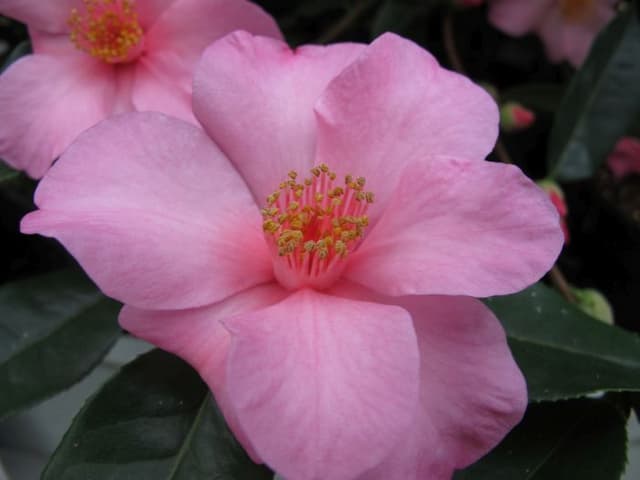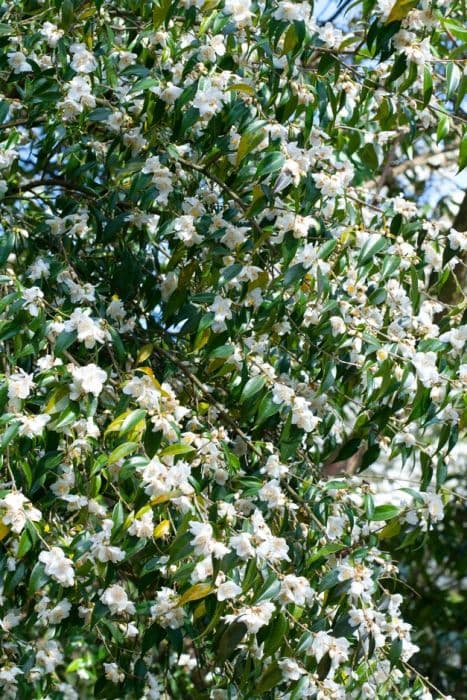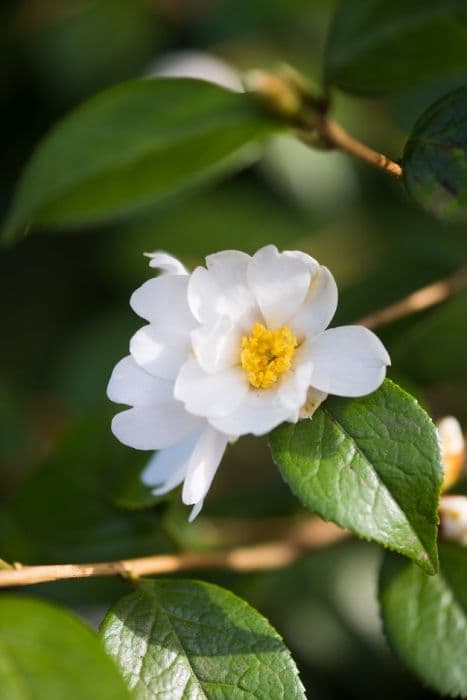Japanese Camellia Camellia japonica Classique = 'Kerguelen' (PBR) (v)

ABOUT
Camellia japonica Classique, also known simply as the Camellia, showcases a stunning display of elegance and beauty. The plant is renowned for its large, showy flowers which bloom in a luxurious shade of deep pink. Each petal boasts an impeccable form, often with a slight ruffle at the edges, adding a touch of opulence to their appearance. The flowers themselves emerge with a perfect symmetry that draws the eye, making them the focal point of the plant. In the heart of these blossoms, a cluster of contrasting yellow stamens stands out, offering an attractive center point. The foliage of the Camellia adds to its charm with glossy, dark green leaves which provide a rich backdrop for the flowers. These leaves are leathery in texture, with a smooth and shiny surface, and have a slightly serrated margin. Their oval shape and pointed tips are characteristic, creating a dense canopy of green throughout the year. The entire plant presents itself with an air of grace and formality, reflecting its status as a popular choice for ornamental gardens. The Camellia gives off a sense of tranquillity and classic beauty that is sure to enhance any setting in which it is placed.
About this plant
 Names
NamesFamily
Theaceae
Synonyms
Japanese Camellia, Japonica, Rose of Winter
Common names
Camellia japonica 'Kerguelen'
 Toxicity
ToxicityTo humans
Camellia japonica, commonly known as Japanese camellia, is not considered toxic to humans. Generally, ingesting parts of this plant does not result in any serious toxicity or poisons symptoms. As with any non-food plant, excessive ingestion might cause mild stomach upset due to it not being part of the human diet, but it is not known for containing hazardous substances that would lead to severe poisoning or life-threatening consequences.
To pets
Japanese camellia is also not considered toxic to pets, including cats and dogs. Similar to humans, the ingestion of parts of this plant is unlikely to cause severe illness or symptoms of poisoning in pets. However, ingestion of non-food plant material can sometimes result in mild gastrointestinal upset in animals, which might manifest as vomiting or diarrhea. If a pet ingests a substantial amount of the plant and shows signs of distress, contacting a veterinarian is advisable.
 Characteristics
CharacteristicsLife cycle
Perennials
Foliage type
Evergreen
Color of leaves
Green
Flower color
Pink
Height
6-10 feet (1.8-3 meters)
Spread
6-10 feet (1.8-3 meters)
Plant type
Shrub
Hardiness zones
7
Native area
Japan
Benefits
 General Benefits
General Benefits- Decorative Flowers: Camellia japonica 'Kerguelen' is known for its aesthetically pleasing flowers, which enhance the visual appeal of gardens and landscapes.
- Seasonal Interest: Produces a stunning display of blossoms during late winter to early spring, providing color when many other plants are dormant.
- Evergreen Foliage: The plant maintains its glossy, dark green leaves year-round, offering continuous greenery and structure in the garden.
- Drought Resistance: Once established, it has moderate drought tolerance, reducing the need for frequent watering.
- Low Maintenance: Requires minimal pruning and care, making it a suitable plant for gardeners of all skill levels.
- Shade Tolerance: Adapts well to partial shade conditions, providing options for planting in diverse locations with varied light availability.
- Privacy Screening: The dense foliage and growth habit can be used to create privacy screens or hedges in residential landscaping.
- Attracts Pollinators: The flowers can attract bees and other pollinating insects, which are beneficial for the garden ecosystem.
 Medical Properties
Medical PropertiesThis plant is not used for medical purposes.
 Air-purifying Qualities
Air-purifying QualitiesThis plant is not specifically known for air purifying qualities.
 Other Uses
Other Uses- Artistic Inspiration: Camellia japonica flowers are often used as subjects in painting and photography due to their vibrant colors and elegant form.
- Religious Symbolism: In some cultures, the Camellia bloom symbolizes devotion and longevity, and it is used in religious ceremonies and rituals.
- Wedding Decor: Because of their beauty and variety of colors, Camellias are sometimes incorporated into floral arrangements and bouquets for weddings.
- Fabric Dye: The petals of Camellia japonica can be used to create natural dyes for coloring fabrics, yielding a range of soft pinks and reds.
- Traditional Games: In Japan, the fallen petals of Camellias are sometimes used for a game called "Tosenkyo" where players try to flip them into a sake cup.
- Handcrafts Material: Dried Camellia petals can be incorporated into handcrafted items such as soaps, candles, and potpourri for their fragrance and aesthetic appeal.
- Culinary Garnish: The edible varieties of Camellia japonica can be used to garnish and enhance the presentation of various dishes.
- Scented Oils: While not as common, Camellia flowers can be used to infuse oils with their scent for making perfumes or aromatherapy products.
- Cultural Festivals: The Camellia is celebrated in various festivals around the world, such as the Camellia Festival held in Locarno, Switzerland.
- Educational Use: Camellia japonica plants can be used in educational settings to teach botany and horticulture principles due to their well-defined structure and growing requirements.
Interesting Facts
 Feng Shui
Feng ShuiThe Camellia is not used in Feng Shui practice.
 Zodiac Sign Compitability
Zodiac Sign CompitabilityThe Camellia is not used in astrology practice.
 Plant Symbolism
Plant Symbolism- Adoration & Perfection: The Camellia japonica is often associated with adoration, signifying the perfection and loveliness of a loved one.
- Longevity & Faithfulness: As an evergreen with long-lasting flowers, the camellia symbolizes eternal life or long-term devotion, hinting at faithfulness in relationships.
- Refinement: With its elegant form and captivating presence, the camellia represents refinement, sophistication, and the perfection of manners and habits.
- Desire & Passion: The luscious and full blooms can convey the intensity of desire or passionate love in certain cultures.
 Water
WaterCamellias, including the Camellia japonica 'Kerguelen', prefer consistently moist soil, but it's important not to overwater them. They should be watered when the top inch of soil feels dry to the touch. Depending on your local climate and weather conditions, this might mean watering every 5-7 days during the growing season. In cooler months, reduce watering to every 10-14 days. Utilize a gentle water stream around the base of the plant to avoid wetting the leaves, which can lead to fungal diseases. Each watering session should provide sufficient moisture to soak the root zone, which might translate to about 1-2 gallons for a typical outdoor shrub.
 Light
LightFor the Camellia japonica 'Kerguelen', bright, indirect light is ideal. They thrive in partial shade, particularly in the morning with some afternoon protection from the intense sun. A spot that receives dappled sunlight throughout the day or is shaded by taller trees or a structure in the afternoon is perfect. Direct summer sun can be too harsh and may cause leaf scorch.
 Temperature
TemperatureCamellia japonica 'Kerguelen' can tolerate a range of temperatures but prefer a cooler climate. They do best in a range with a minimum temperature of 20°F to a maximum of 80°F. The ideal growing temperature for camellias is between 40°F and 70°F. Camellias can survive brief periods of colder weather, but prolonged exposure to temperatures below 20°F can be detrimental.
 Pruning
PruningPruning Camellia japonica 'Kerguelen' enhances air circulation and maintains a tidy shape. Prune right after the flowers have faded in late winter or early spring before new growth starts. Remove any dead or damaged branches and trim back any that disrupt the plant's form. Selective thinning rather than shearing encourages a natural shape and healthy growth.
 Cleaning
CleaningAs needed
 Soil
SoilCamellia, or Japanese camellia, thrives in well-draining, acidic soil with a pH of 5.5 to 6.5. A blend of one-third peat moss, one-third compost, and one-third perlite or pine bark fines is ideal. It is important to ensure the soil mixture is kept moist, but not waterlogged, to promote healthy growth.
 Repotting
RepottingJapanese camellias generally require repotting every two to three years to refresh the soil and provide room for growth. Younger camellias may benefit from annual repotting, while mature plants might be repotted less frequently, especially if they're planted in the ground.
 Humidity & Misting
Humidity & MistingCamellias prefer a high humidity level, around 50-60%. Consistent humidity helps promote lush foliage and vibrant blooms. It is essential to maintain these levels, especially during the dry winter months or in arid climates.
 Suitable locations
Suitable locationsIndoor
Place in bright, filtered light, away from heat sources, and maintain high humidity.
Outdoor
Plant in partial shade, shelter from cold winds, in well-draining acidic soil.
Hardiness zone
7-9 USDA
 Life cycle
Life cycleCamellia japonica Classique, commonly known as Japanese camellia, begins its life cycle from seed germination, requiring well-drained, acid soil and dappled shade. Seedlings emerge and develop into young plants, with glossy, evergreen leaves establishing over several months. As the plant matures, typically after 2-5 years, it begins to produce the characteristic ornate flowers, ranging in color and form, during late winter to spring. After pollination, usually by bees, the flowers develop into dry capsules, which upon maturity release seeds to start the next generation. The plant continues to grow and can live for many years, with pruning and care to encourage bushiness and abundant flowering. Camellia japonica experiences dormancy during the cooler seasons, with growth resuming in the warmer months.
 Propogation
PropogationPropogation time
Spring-Early Summer
The most popular method of propagation for Camellia japonica 'Classique' ('Kerguelen') is through semi-hardwood cuttings. This process usually takes place during the late summer. To propagate using this method, a gardener would take a cutting that is about 4 to 6 inches long from the current year’s growth, making sure to include at least two sets of leaves. The lower leaves are removed, and the cut end is often treated with a rooting hormone to encourage root development. The cutting is then planted in a mixture of moist peat and perlite or sand, and placed in a warm location with filtered light. Ensuring the cutting has a humid environment can be critical, which can be achieved by covering it with a plastic bag or placing it in a propagator. Roots typically develop within a few months, after which the new plant can be transferred to a larger pot or directly to the garden.









